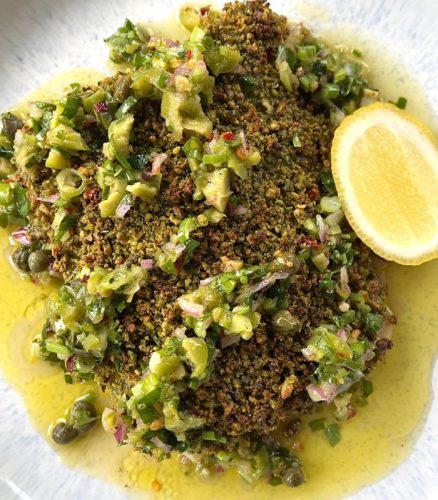Before we get into it, let’s level set that this is not just a random breakfast. The Turkish breakfast, which in Turkey you can even get at a roadside equivalent of 7-Eleven, is a lavish feast. (And it was the best meal of a recent trip.) It’s where small plates of everything from cheeses to eggs to olives to cucumbers to honey are brought out, and you can’t help but get involved. Here’s how to do up your own.
If you thought breakfast was the most important meal of the day in America, you’re in for some Turkish delight (sorry, we had to). Breakfast in Turkey is a cultural staple, something to be enjoyed around the table with friends and family at the start of each day. It’s an arrangement of small plates and bowls filled with an array of complementary flavors. Creating your own Turkish breakfast at home is easier than you may think. Pull out the ramekins, make sure you’re stocked up on black tea, and get ready for one of the most satisfying breakfasts of your life.
No Turkish breakfast lineup is exactly the same, and the best part is how easily customizable your selection can be. No matter what you choose, these are the staples that should be on your table:
 Jam
Jam
We like raspberry and fig, but any variety works. Many Turkish breakfasts will also include more unique flavors like orange marmalade and sour cherry.
Honey and Cream
While clotted cream is used as the traditional bed for a drizzle of honey, mascarpone will replicate that creamy texture just fine.

Olives
Store-bought olives will work fine as is, but we prefer ours marinated in olive oil and aromatics. See a quick preparation here.
Cured Meat
The typical meat you’ll find in a Turkish breakfast is sujuk, a cured Turkish sausage. While the meat is available online, you can also save yourself the trouble by picking a few of your favorite cured meats. We went with salami. But prosciutto or Spanish chorizo will work, too.

Cucumber and Tomatoes
Cucumbers and tomatoes are a staple in these breakfast spreads, and can be served in a number of ways. We recommend simply slicing the veggies up and serving with olive oil, pepper, and salt. Bonus points if you dip in labneh (a creamy yogurt cheese).
Cheese
Typically, breakfast will include a few cheese options. Popular cheeses in Turkey include Lor and Tulum Peyniri, two crumbly white cheeses varying in saltiness. We opted for feta, which is both common in Turkish breakfast spreads and easy to find in the States.

Eggs
Traditionally, a spicy scramble called menemen is served up in a Turkish breakfast spread. But due to the accessibility of sujuk, we went with the more attainable çilbir, or Turkish poached eggs over yogurt. See the recipe below.

Bread
Simit, Turkish pide bread, flatbread. Whatever form you choose, bread is a staple of a Turkish breakfast. See below for a Simit recipe, a Turkish bread similar to a bagel.
Recipes for a Turkish Breakfast

Çilbir, or Turkish Eggs
Ingredients
4 eggs
A dash of white vinegar
1 cup of labneh or greek yogurt
3 garlic cloves, minced
1 tbsp of chopped fresh dill
2 tsp of Aleppo pepper
4 tbsp of salted butter
Black pepper
Flaky salt
Directions
Begin by making your Aleppo butter. In a saucepan, melt the salted butter over medium heat. Allow to cook for about 5 minutes, swirling occasionally, until the butter is browned and has a deep, nutty aroma. Turn off the heat, stir in the Aleppo pepper and set aside.
To make the garlic yogurt, combine the yogurt or labneh, minced garlic, dill, and black pepper to taste. Mix well and set aside.

Next, bring a pot of water to a rolling boil, then reduce heat to low. Crack one egg into a fine mesh sieve placed over a small bowl, then transfer the egg to the bowl. Add a dash of vinegar to the water and use a spoon to swirl the water into a steady vortex. Pour the egg from the bowl into the vortex and cook for 3 minutes, using a slotted spoon to remove. Repeat this process with the remaining three eggs.
To plate, spread the garlic yogurt into an even and thick layer. Place the four poached eggs on top of the yogurt, and spoon the browned Aleppo butter over the top. Garnish with more dill and flaky salt.

Simit
Ingredients
2 tsp of instant yeast
1 tsp of salt
1 tablespoon of granulated sugar
4 cups of bread flour
1 1/2 cup of warm water
1/4 cup of vegetable oil
1/4 cup of honey
1/2 cup of water
1 1/2 cup of sesame seeds
Directions
In the bowl of your stand mixer, combine the dry ingredients of sugar, yeast, flour, and salt. Add the warm water and oil, mixing with the dough hook until you have a slightly sticky, well incorporated dough. Continue to mix for about 8 minutes until the dough is no longer sticky, adding more flour if it’s still too wet. Cover the bowl with a clean kitchen towel and let the dough rise for about an hour and a half, or until it has doubled in size.
While the dough rises, toast your sesame seeds in a dry pan. Next, mix the honey and water together in a wide, shallow bowl. Set aside.
After the dough has risen, punch it down and divide it into 16 even pieces. Working with two pieces at a time, roll each piece out into tubes, about 2 feet long each. Lay the tubes next to each other, wrapping them in opposite directions to create a twisted rope. Meet the ends and pinch them together to make a ring. Repeat this process with the remaining 14 pieces, creating seven more rings.

Line a baking sheet with parchment paper. Dip each ring first into the honey and water mixture, then into a bowl of toasted sesame seeds. Place the rings on the baking sheet, then cover loosely and let rise for an additional 20 minutes. Use this time to preheat your oven to 400 degrees.
After the second rise, bake the limits in the oven for 12 to 15 minutes, or until they’re golden brown and well-cooked. Enjoy with your çilbir, labneh, cream and honey, and jam!



























































































































